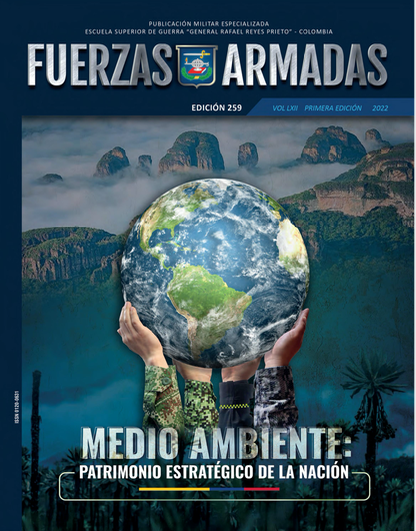Las Fuerzas Militares como instrumento de conservación ambiental
DOI:
https://doi.org/10.25062/0120-0631.393Resumen
La contaminación por mercurio constituye una de las problemáticas ambientales de mayor relevancia en el país debido en mayor medida a que el uso indiscriminado de esta sustancia en actividades mineras e industriales ha ocasionado el detrimento del ecosistema. Sin embargo, es insuficiente el conocimiento que se tiene en el país de la problemática generada por la liberación de mercurio en los diferentes compartimientos ambientales y su impacto en el deterioro del ecosistema y la salud humana. Adicionalmente, considerando que la minería artesanal del mercurio es en gran parte controlada por actores armados ilegales, las Fuerzas Militares tienen un rol importante en el control de estos grupos y por ende son un actor de vital importancia en la conservación medioambiental de Colombia.
Biografía del autor/a
Wilder Leonardo Gamboa Ruiz, Universidad Militar Nueva Granada
Docente Departamento de Química (Universidad Militar Nueva Granada). Químico (Universidad Nacional); master en Calidad en laboratorios analíticos (Universidad de Faro/Universidad de Barcelona); doctor en Ciencias (Universidad de Kagoshima).
Referencias bibliográficas
Athar, R. & Ahmad, M. (2002). Heavy Retal toxicity: effect on plant growth and metal uptake by wheat, and on free living Azotobacter. Water, Air, and Soil Pollution, 138(1) 165-180. https://doi.org/10.1023/A:1015594815016
Bai, P., Canto, C, Brunyánszki, A., Huber, A., Szántó, M., Cen, Y.,... & Auwerx, J . (2011). PARP-2 regulates SIRT1 Expression and whole-body energy expenditure. Cell metabolism, 13(4), 450-460. https://doi.org/10.1016/j.cmet.2011.03.013
DO VALLE, Cláudia M., et al. Speciation and quantification of mercury in Oxisol, Ultisol, and Spodosol from Amazon (Manaus, Brazil). Chemosphere, 2005, vol. 58, no 6, p. 779-792. https://doi.org/10.1016/j.chemosphere.2004.09.005
Frey, B., & Rieder, S. R. (2013). Response of forest soil bacterial communities to mercury chloride application. Soil Biology and Biochemistry, 65, 329- 337. https://doi.org/10.1016/j.soilbio.2013.06.001
Gallego, E. A. (1996). Tradición jurídica y derecho subjetivo. Librería-Editorial Dykinson.
Gabriel, M. C , & Williamson, D. G. (2004). Principal biogeochemical factors affecting the speciation and transport of mercury through the terrestrial environment. Environmental geoche mistry and health, 26(3), 421-434. https://doi.org/10.1007/s10653-004-1308-0
Graeme, K. A., & Pollack Jr, C. V. (1998). Heavy metal toxicity, part I: arsenic and mercury. The Journal of emergency medicine, 16(1), 45-56. https://doi.org/10.1016/S0736-4679(97)00241-2
Grigoratos, D., Knowles, J., Ng, Y. L, & Gulabivala, K. (2001). Effect of exposing dentine to sodium hypochlorite and calcium hydroxide on its flexural strength and elastic modulus. International endodontic journal, 34(2), 113-119. https://doi.org/10.1046/j.1365-2591.2001.00356.x
Hahladakis, J., Smaragdaki, E., Vasilaki, G., & Gidarakos, E. (2013). Use of sediment quality guidelines and pollution indicators for the assessment of heavy metal and PAH contamination in Greek surficial sea and lake sediments. Environmental monitoring and assessment, 185(3), 2843-2853. https://doi.org/10.1007/s10661-012-2754-2
Islam, S., Ahmed, K., & Masunaga, S. (2015). Potential ecological risk of hazardous elements in different land-use urban soils of Bangladesh. Science of the total environment, 512, 94-102. https://doi.org/10.1016/j.scitotenv.2014.12.100
Kim, K.H., Choi, G.H., Kang, C.H., Lee, J.H., Kim, J.Y., Youn, Y.H. and Lee, S.R. (2003). The Chemical Composition of Fine and Coarse Particles in Relation with the Asian Dust Events. Atmos. Environ. 37: 753- 765. https://doi.org/10.1016/S1352-2310(02)00954-8
Liu, J., Xu, X., Wu, K., Piao, Z., Huang, J., Guo, Y, Li, W., Zhang, Y, Chen, A. and Huo, X. (2011). Association between Lead Exposure from Electronic Waste Recycling and Child Temperament Alterations. Neurotoxicology. https://doi.org/10.1016/j.neuro.2011.03.012
Naidu, R., & Harter, R. D. (1998). Effect of different organic ligands on cadmium sorption by and extractability from soils. Soil Science Society of America Journal, 62(3), 644- 650. https://doi.org/10.2136/sssaj1998.03615995006200030014x
Rasmussen, L. D., & Sorensen, S. J. (2001). Effects of mercury contamination on the cultürable heterotrophic, functional and genetic diversity of the bacterial community in soil. FEMS microbiology ecology, 36(1), 1-9. https://doi.org/10.1111/j.1574-6941.2001.tb00820.x
Sánchez-Chardi, A., Ribeiro, C. A. O., & Nadal, J. (2009). Metals in liver and kidneys and the effects of chronic exposure to pyrite mine pollution in the shrew Crocidura russulainhabiting the protected wetland of Doñana. Chemosphere, 76(3), 387-394. https://doi.org/10.1016/j.chemosphere.2009.03.036
Sekabira, K., Origa, H. O., Basamba, T. A., Mutumba, G./& Kakudidi, E. (2010). Assessment of heavy metal pollution in the urban stream sediments and its tributaries. International journal of environmental science & technology, 7(3), 435-446. https://doi.org/10.1007/BF03326153
Zhang, G., Xie, H., Kang, S., Yi, D., & Ackley, S. F. (2011). Monitoring lake level changes on the Tibetan Plateau using ICESat altimetry data (2003-2009). Remote Sensing of Environment, 115(7), 1733-1742. https://doi.org/10.1016/j.rse.2011.03.005
Cómo citar
Descargas
Descargas
Publicado
Número
Sección
Licencia
Derechos de autor 2022 Fuerzas Armadas

Esta obra está bajo una licencia internacional Creative Commons Atribución-NoComercial-SinDerivadas 4.0.

| Estadísticas de artículo | |
|---|---|
| Vistas de resúmenes | |
| Vistas de PDF | |
| Descargas de PDF | |
| Vistas de HTML | |
| Otras vistas | |













